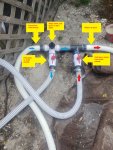Hi all. I recently installed a few solar panels to heat my above ground intex 12'x30" pool. My solar panels lay flat on my deck. I have an intex 2500gph pump that pushes water to a three way valve that I have at full open (all 3 sides open). The right side of the three way valve pushes water to the solar panels. Then the output of the solar panels is run to a PVC "T" junction and returned to the pool. A pic of my setup is here:
My question is this: how is the pressure at the "T" junction not going to push cold water BACK into my solar return line when I have the three way valve completely open? I'm having a hard time wrapping my brain around that one. Im worried that the straight flow between the three way valve and the "T" junction will outweigh the pressure of the return hose, i.e., forcing water back into the solar panels, intead of letting the warm solar water back into the pool return line. Can someone explain to me how my setup works in terms of pressure, or if there are any glaring problems with the way I have it set up?
Thanks!
My question is this: how is the pressure at the "T" junction not going to push cold water BACK into my solar return line when I have the three way valve completely open? I'm having a hard time wrapping my brain around that one. Im worried that the straight flow between the three way valve and the "T" junction will outweigh the pressure of the return hose, i.e., forcing water back into the solar panels, intead of letting the warm solar water back into the pool return line. Can someone explain to me how my setup works in terms of pressure, or if there are any glaring problems with the way I have it set up?
Thanks!


